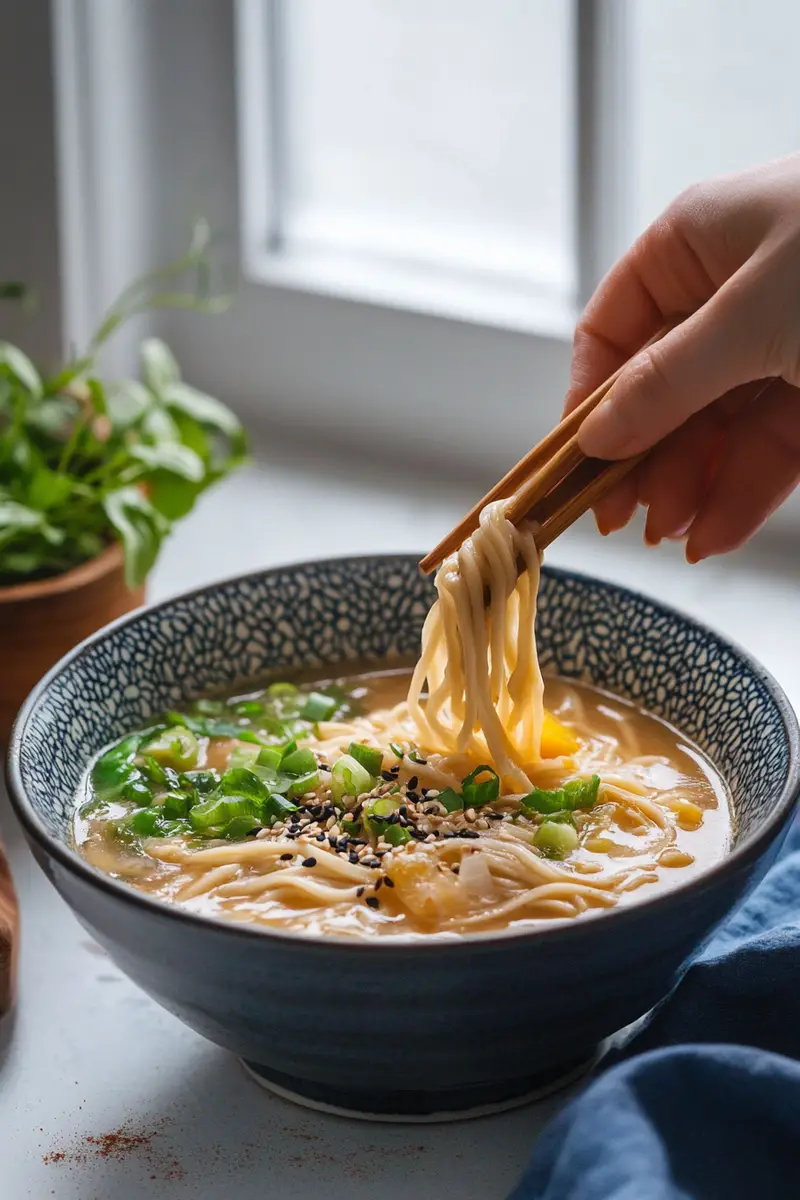Introduction and Quick Summary
Ramen Noodle Soup is not just a meal; it’s an experience that warms your heart and satisfies your cravings. Originating from Japan, this beloved dish has become a global sensation thanks to its rich flavors and versatility. Whether you are looking for a quick lunch or a cozy dinner option, mastering the art of making this delicious soup at home can elevate your cooking game. With its savory broth, tender noodles, and an array of toppings, Ramen Noodle Soup allows each person to customize their bowl to perfection.
In this article, we will guide you through the process of creating a scrumptious bowl of Ramen Noodle Soup from scratch. We’ll break down the essential ingredients you need and provide step-by-step instructions for preparing the soup. Plus, we’ll share some valuable serving and storing tips to ensure your dish remains delightful even days later. Get ready to embark on a culinary adventure that brings the flavors of Japan right into your kitchen!
Main Ingredients
To create an authentic Ramen Noodle Soup, you’ll need to gather several core ingredients. Each component plays a crucial role in developing the rich flavor profile that makes this dish so special.
Broth
The backbone of any great Ramen Noodle Soup is its broth. Traditionally made from pork bones or chicken stock, the broth should be simmered for hours to extract deep flavors. You can also use vegetable stock for a lighter version. Aim for about 6 cups of broth to serve four people adequately.
Noodles
Ramen noodles are uniquely crafted for this dish. They come in various styles but ensure you choose fresh or dried wheat noodles specifically labeled as ramen. Typically, you’ll need about 8 ounces (approximately 225 grams) of noodles per serving. Fresh noodles will cook faster than dried ones, so adjust your cooking time accordingly.
Protein
For protein options, traditional ramen often features sliced pork belly (chashu) or soft-boiled eggs. However, tofu is an excellent alternative for vegetarians or those seeking lighter options. Use about 1 pound (450 grams) of meat or tofu per batch to ensure every bowl is satisfying.
Vegetables
Fresh vegetables add both color and nutrition to your ramen bowl. Common choices include green onions (scallions), bok choy, mushrooms (shiitake or enoki), and bean sprouts. Aim for around 2 cups of mixed vegetables per serving – feel free to experiment with seasonal produce!
Toppings
Toppings elevate your ramen experience with texture and flavor complexity. Classic toppings include nori (seaweed), sesame seeds, chili oil, and pickled ginger. You can also add corn or bamboo shoots as desired. About ¼ cup of mixed toppings per bowl will enhance both presentation and taste.
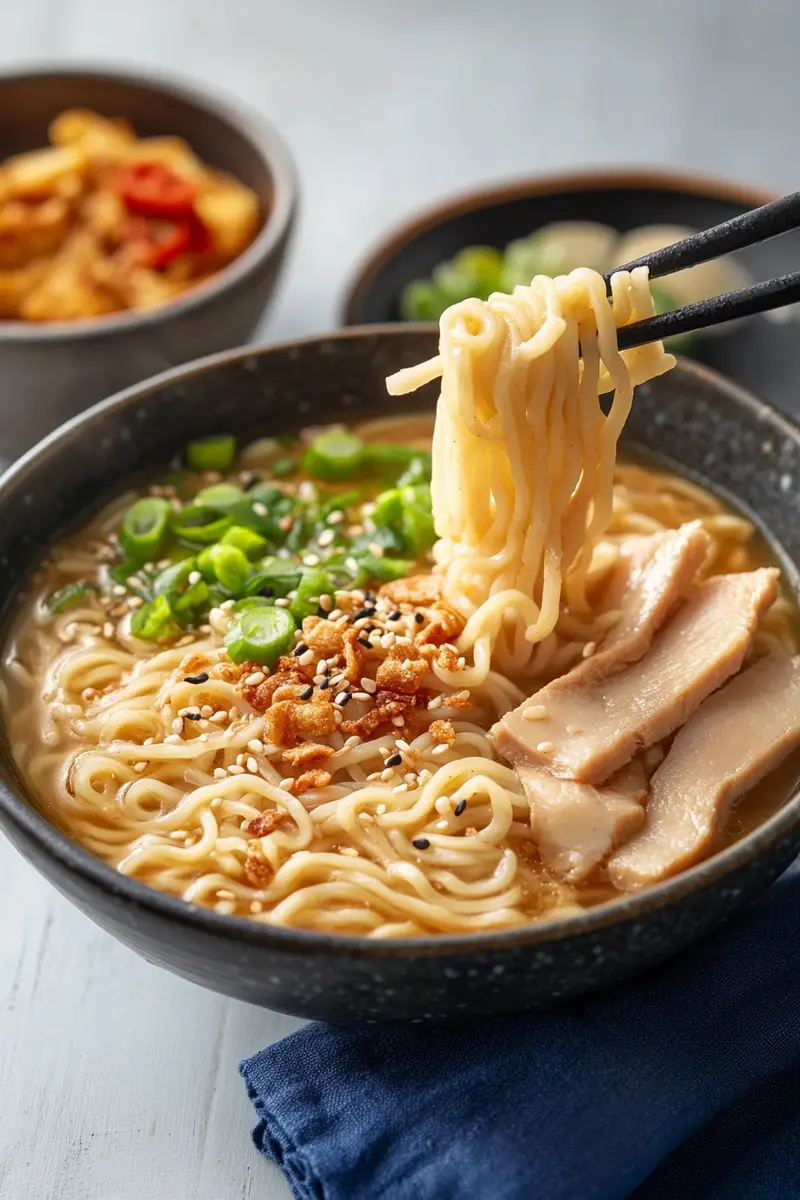
How to Prepare Ramen Noodle Soup
Making Ramen Noodle Soup involves several steps that transform simple ingredients into a sensational meal.
Step 1: Prepare the Broth
Start by choosing your base broth: pork bone or chicken stock works best for traditional ramen flavors. In a large pot over medium heat, add your chosen meat bones and cover them with water—roughly 8 cups should do it. Bring it to a boil then reduce the heat to low and let it simmer gently for at least 4 hours; add aromatics like garlic, ginger, and scallions halfway through for added depth in flavor.
Once done simmering, strain out any solids leaving behind a clear broth—this will be the foundation of your ramen soup! Season with soy sauce or miso paste according to taste preferences; just remember that you can always add more later but cannot take away!
Step 2: Cook the Noodles
While your broth is simmering away creating all those delicious flavors, it’s time to cook the noodles! In another pot filled with boiling water—follow package instructions—add in approximately 8 ounces of ramen noodles directly into bubbling water while stirring occasionally until they reach al dente texture (usually around 3–5 minutes). Drain them carefully then rinse under cold water briefly preventing stickiness before setting aside till needed later on.
This step ensures that each bite offers perfect chewiness without turning mushy when added into hot soup later.
Step 3: Prepare Your Protein
Now let’s focus on prepping proteins! If using chashu pork belly cut into thin slices after braising them in soy sauce mixture until tender (about an hour). For soft-boiled eggs simply place eggs into boiling water for exactly six minutes then transfer immediately into ice bath ensuring they peel easily afterward! Alternatively prepare cubed tofu by pan-frying until golden brown achieving crisp edges enhancing overall texture within bowls later on during assembly phase.
Having proteins prepared ahead saves valuable time allowing faster assembly while ensuring everything remains fresh upon serving guests!
Step 4: Assemble Your Bowl
Finally comes assembly! Start by ladling piping hot broth generously over cooked ramen noodles filling up each bowl about two-thirds full—this ensures maximum warmth throughout consumption experience! Next layer sliced proteins followed by vibrant assortment vegetables such as scallions topped off with desired garnishes like nori strips along side sesame seeds drizzle chili oil if preferred! Serve immediately while still steaming hot allowing everyone enjoy flavorful masterpiece created from scratch together!
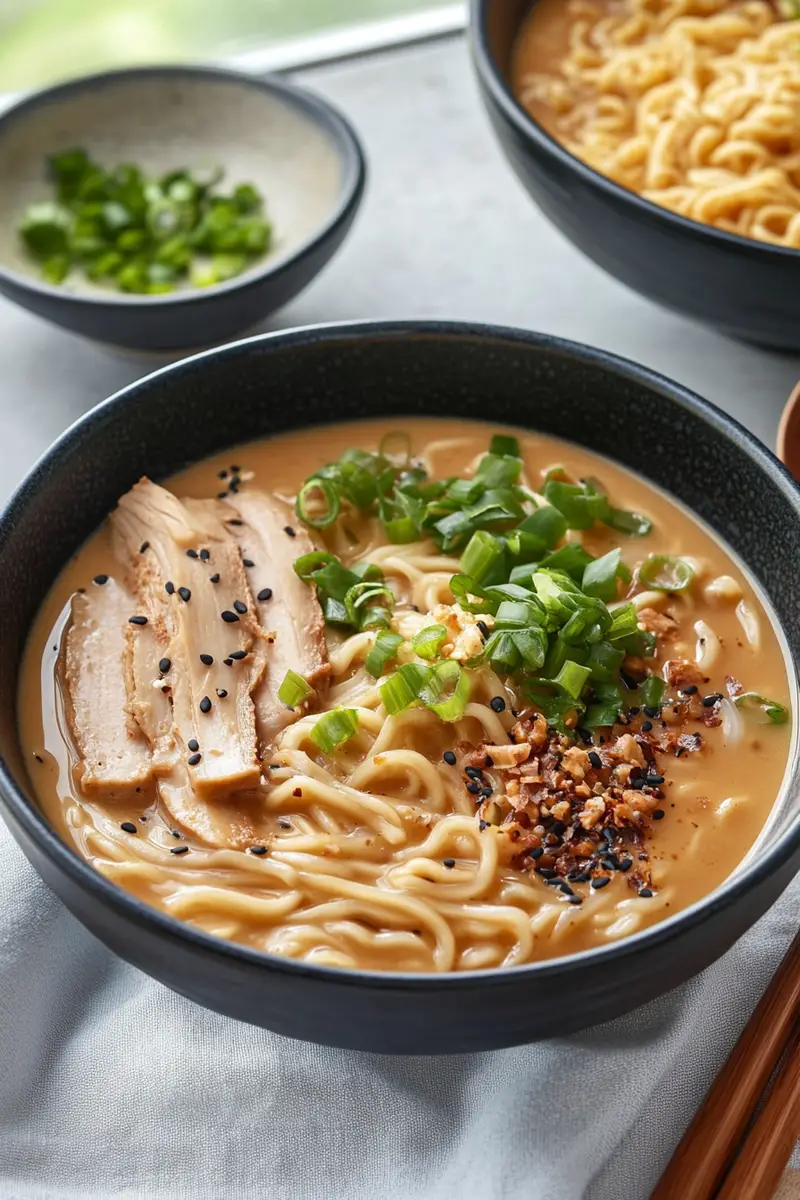
Serving and Storing Tips
To truly enjoy your homemade Ramen Noodle Soup experience fully understanding proper serving methods is crucial along side appropriate storage techniques after enjoying leftovers!
Serving Suggestions
When serving Ramen Noodle Soup aim for visually appealing presentations that entice diners even before first bites occur! Provide individual bowls holding warm broths where guests can customize their own creations by adding preferred toppings such as green onion slices alongside chili flakes bringing vibrancy across tablescapes during gatherings inviting conversation among friends family alike around shared meals together create unforgettable moments beyond mere nourishment alone!
Encourage creativity encouraging guests explore different combinations discovering unique flavor profiles tailored specifically suited each person’s palate enhancing overall culinary adventure shared amongst loved ones making memories cherished long after last spoonful consumed!
Storage Tips
If there happens remain leftovers after enjoying delectable feast don’t fret! To store leftover components properly separate cooked noodles from broth within airtight containers refrigerating promptly prevents spoilage extending shelf life significantly allowing enjoyment beyond initial meal prep session ideally consumed within three days maximum freshness retained effectively preserving all original flavors intact avoiding unnecessary waste while savoring delightful creation time again later down line whenever cravings arise once more!
When reheating always rewarm broth separately bringing back optimal temperatures before combining together again ensuring best possible results experienced once more reliving joyful moments shared previously whilst indulging again deliciousness brought forth through careful preparation effort put forth earlier ultimately culminating success represented beautifully final presentation served proudly table side ready delight hungry appetites awaiting eagerly first bites taken reminding everyone why loving culture surrounding flavorful dishes traditional recipes passed generations near far continues thrive today inspiring cooks everywhere strive recreate magic home kitchens around world effortlessly blending traditions heritage rich tapestry culinary delights explored further depths journey awaits each recipe tried discovered anew every single day!
Mistakes to Avoid
One of the most common mistakes when making Ramen Noodle Soup is using the wrong noodles. Not all ramen noodles are created equal. Some types are better suited for specific styles of ramen, while others may not hold up well in broth. Always choose fresh or dried ramen noodles specifically designed for soup, as they will provide the best texture and absorb flavors effectively.
Another frequent error is overcooking the noodles. Ramen noodles should have a firm bite, known as “al dente.” Overcooked noodles become mushy and lose their appeal. To avoid this, cook the noodles separately according to package instructions and add them to the soup just before serving. This helps maintain their texture and prevents them from becoming soggy.
Ignoring the importance of broth flavor is another pitfall. The broth is the heart of your Ramen Noodle Soup. Skimping on seasoning or using low-quality stock can result in a bland dish. Take time to create a rich broth by simmering bones, vegetables, and spices together. Don’t forget to taste and adjust seasoning as necessary for a well-balanced flavor profile.
Finally, neglecting garnishes can detract from your dish’s overall experience. Garnishes not only enhance visual appeal but also add layers of flavor and texture. Common toppings include green onions, soft-boiled eggs, nori (seaweed), and mushrooms. Experiment with different combinations to find what complements your ramen best.
Tips and Tricks
To elevate your Ramen Noodle Soup, consider using homemade broth instead of store-bought options. Homemade broth allows you to control flavors and ingredients fully. Simmer bones with aromatics like garlic, ginger, and scallions for several hours to extract maximum flavor. This extra step significantly enhances the depth of your soup.
When preparing toppings, consider marinating proteins like chicken or pork in soy sauce or miso paste beforehand. This step infuses them with additional flavor that complements the soup perfectly. Also, try quick-pickling vegetables such as radishes or cucumbers for a refreshing crunch that contrasts beautifully with the warmth of the broth.
Don’t hesitate to experiment with different flavor profiles! While traditional ramen often features soy sauce or miso-based broths, you can explore various ingredients like coconut milk or curry paste for a unique twist on Ramen Noodle Soup. Adapt your recipe based on seasonal ingredients or your personal preferences.
Lastly, pay attention to presentation when serving your Ramen Noodle Soup. Use deep bowls that allow you to layer noodles at the bottom followed by broth and toppings artfully arranged on top. A visually appealing presentation enhances dining experience significantly.
Suggestions for Ramen Noodle Soup
Choose high-quality ingredients whenever possible for your Ramen Noodle Soup recipe. Fresh produce ensures vibrant flavors while premium meats contribute richness to the dish. Seek out local farmers’ markets or specialty stores for fresh vegetables and ethically sourced meats.
If you’re short on time but still want a delicious bowl of ramen, consider meal prepping some components ahead of time. You can prepare the broth in advance and freeze it in portions so you can easily reheat it later for quick meals during busy days.
For those who enjoy spicy food, incorporating chili oil or Sriracha into your ramen can add an exciting kick! Adjust spice levels according to personal preference; start with small amounts if you’re unsure how much heat you desire.
Lastly, don’t forget about dietary restrictions when making Ramen Noodle Soup! Substitute regular noodles with gluten-free options if necessary or use vegetable-based broths for plant-based diets without compromising flavor quality.
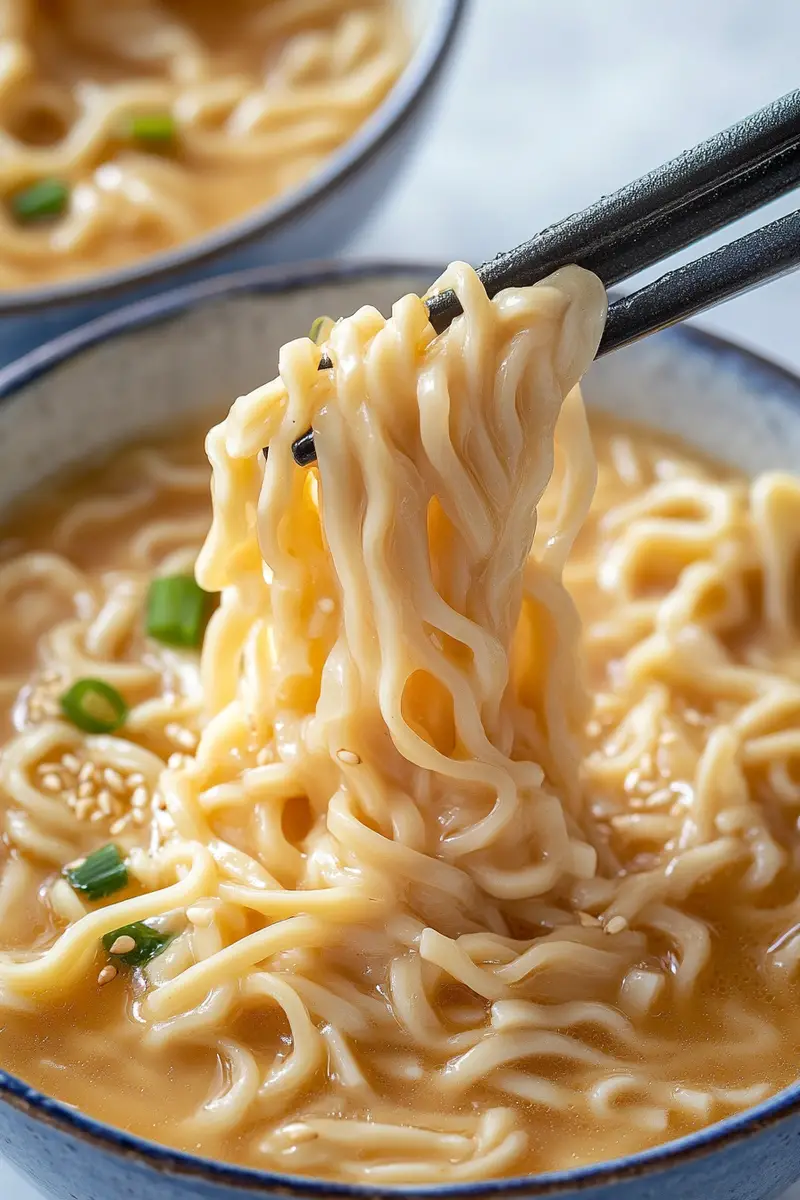
FAQs
What types of noodles are best for Ramen Noodle Soup?
The best types of noodles for Ramen Noodle Soup are typically fresh or dried ramen made specifically for soups. Look for brands that specify “ramen” on their packaging rather than generic wheat noodles or instant varieties which might not hold up well in hot broth.
Can I make Ramen Noodle Soup vegetarian?
Absolutely! Making a vegetarian version of Ramen Noodle Soup is easy by substituting meat-based broths with vegetable stock or miso broth instead while ensuring all toppings align with vegetarian choices; this allows you to enjoy delicious flavors without meat products!
How long does it take to prepare homemade broth?
Preparing homemade broth usually takes around 4-6 hours depending on whether you’re using bones like pork or chicken; simmering longer extracts more flavor from these components resulting in richer tasting broth perfect for enhancing any bowl of ramen noodle soup.
What are some essential toppings I should include?
Key toppings that elevate any bowl include sliced green onions, soft-boiled eggs (marinated if desired), nori (seaweed), mushrooms such as shiitake or enoki variety along with bok choy which adds freshness—each component contributes its unique texture/flavor enhancing overall experience!
Can I freeze leftover Ramen Noodle Soup?
Yes! If you have leftover soup after enjoying it once frozen portions make great reheatable meals later on; however remember not to freeze previously cooked noodles as they may become mushy upon thawing—store them separately from the stock!
How do I store leftover ramen?
Store leftover ramen in an airtight container placed inside refrigerator within two hours after cooking; consume within three days maximum period maintaining optimal freshness while preventing spoilage—reheat carefully ensuring no loss in quality during warming process!
Conclusion
In conclusion, mastering Ramen Noodle Soup requires attention to detail regarding ingredients and techniques used throughout preparation stages! Avoid common mistakes such as choosing incorrect noodles or overcooking them while also considering garnishes which enhance both aesthetics/flavors immensely—these elements transform basic bowls into delightful culinary experiences! By implementing tips like utilizing homemade broths alongside experimenting with various spices/seasonings allows endless variations tailored according dietary needs/preferences! Lastly remember storing leftovers properly ensures longevity without compromising quality allowing enjoyment multiple times over—get creative & savor deliciousness today!
Print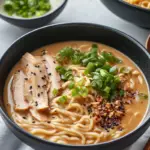
Homemade Ramen Noodle Soup Recipe
- Total Time: 30 minutes
- Yield: 2 servings 1x
Description
Warm, flavorful, and customizable, this homemade ramen noodle soup is perfect for a cozy meal. It’s a delicious blend of rich broth, tender noodles, and fresh toppings!
Ingredients
For the Broth
- 4 cups chicken or vegetable broth
- 2 cups water
- 2 tbsp soy sauce
- 1 tbsp miso paste (optional)
- 2 garlic cloves, minced
- 1-inch piece of ginger, sliced
- 1 tbsp sesame oil
For the Noodles and Toppings
- 2 servings of ramen noodles
- 1 cup sliced mushrooms
- 1 cup chopped bok choy
- 2 soft-boiled eggs
- 1/4 cup sliced green onions
- Optional: shredded chicken, tofu cubes, or bean sprouts
Instructions
- Prepare the Broth:
- Heat sesame oil in a pot over medium heat. Sauté garlic and ginger until fragrant.
- Add chicken or vegetable broth, water, soy sauce, and miso paste. Stir well.
- Simmer for 10-15 minutes to allow flavors to meld.
- Cook the Noodles:
- Cook ramen noodles according to package instructions. Drain and set aside.
- Prepare Toppings:
- Sauté mushrooms and bok choy in a small pan until tender. Set aside.
- Prepare soft-boiled eggs by boiling for 6 minutes, then cooling in an ice bath. Peel carefully.
- Assemble the Ramen:
- Divide noodles into two bowls. Ladle hot broth over the noodles.
- Top with mushrooms, bok choy, soft-boiled eggs, green onions, and any additional toppings of your choice.
Notes
- For a spicier broth, add chili oil or red pepper flakes.
- Miso paste adds depth to the broth but can be omitted for a lighter flavor.
- Customize toppings to suit your taste; use leftover vegetables or proteins.
- Prep Time: 10 minutes
- Cook Time: 20 minutes
Nutrition
- Calories: 350
- Sodium: 900mg
- Fat: 12g
- Carbohydrates: 45g
- Fiber: 3g
- Protein: 15g

